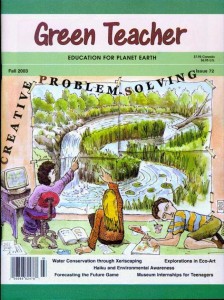Green Teacher 72, Fall 2003
 Features
Features
From Learners to Leaders: Using Creative Problem Solving in Environmental Projects by David Bauer, David Hetherly and Susan Keller-Mathers
Developing, implementing and constructing environmental projects from inception to end gives students the confidence, empowerment and leadership skills they’ll need later to make a difference in the world. Using a case study of Buffalo area high school students who developed a schoolyard pond ecosystem as a model, the authors show how the step-by-step creative problem solving approach is an effective tool for environmental learning.
Haiku-writing: Learning from the Pine by Naomi Beth Wakan
Writing haiku poetry helps students to pay attention to the moment, and grasp the interconnectedness of all things – important tools to developing environmental awareness.
Creating a Map for Eco-Art Education by Hilary Inwood
Environmental art teaches ecological concepts as well as artistic ones, and can strengthen students’ connections with the places they live. Perspective article that includes suggestions for green art projects.
Earth’s Magic Mud by Kathleen Bailer
Reusable, biodegradable and infinitely transformable, clay is nature’s perfect classroom material and one that enables children’s hands to come in contact with the following elements and forces that make up the Earth: water, rock, ice and erosion. Bailer offers guidelines for using clay with pre-school and school-aged children.
Teaching Water Awareness Through Xeriscaping by Cheri Vogel
Xeriscaping, a landscaping technique that minimizes water use in gardens, can provide ideal hands-on projects that help students learn about the water cycle and the interrelationship between soil, plants and water. The author outlines the seven principles of xeriscaping and provides several teaching activities that explore these principles.
Forecasting Congress: Envisioning the Future by Jan Cincera
A secondary level teaching futures activity that asks students to consider eight preferred and possible future scenarios, stimulating discussion about impending global problems, and generating ideas about what can be done now to ensure a better future.
The Water Game by Jennifer Baron
A fun activity that teaches young children about the many phases and forms of H2O, while reinforcing the message that we must protect our limited supply of fresh, clean water.
Museum Internship Programs for Young People: Ten Tips for Success by Sharon A. Hollander
Using the New Jersey State Aquarium’s highly successful museum internship program for high school students as a model, the article offers ten tips, based on the experience of the successful program, for anyone interested in developing innovative and inclusive programming for youth.
And as always, over 20 new educational resources are profiled and evaluated in this issue of Green Teacher.
Leave a Reply
You must be logged in to post a comment.





